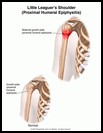
Little Leaguer's Shoulder
What is Little Leaguer's shoulder?
Little Leaguer's shoulder is an overuse injury to the growth area of the upper arm bone (humerus) at the shoulder joint. This growth area, or growth plate, is called the proximal humeral physis. Little Leaguer's shoulder is also called proximal humeral epiphysitis. It happens to young athletes who are still growing.
How does it occur?
Little Leaguer's shoulder occurs from overuse. Repeated throwing causes wear and tear to the growth plate, so that it becomes irritated or inflamed.
Little Leaguer's shoulder is most often seen in young baseball pitchers between the ages of 11 and 16. It can also occur in baseball players playing other positions, as well as tennis players or participants in other throwing sports. Youngsters who play baseball year-round are more likely to have overuse injuries.
What are the symptoms?
The main symptom is pain in the upper arm at the shoulder during throwing. Your child may keep having pain and tenderness after the throwing is over. The shoulder muscle may be weak. The more a young athlete throws and the faster he or she throws, the more likely it is that the pain will get worse. Some pitchers complain that they can no longer throw as fast or as accurately.
How is it diagnosed?
Your healthcare provider will ask about your child's medical history and symptoms and examine your child's shoulder. Many times a young athlete will complain of pain but have a normal physical exam.
An X-ray may be done of your child's shoulder. The X-ray may show a widening of the growth plate of the humerus at the shoulder joint. This X-ray is often compared to an X-ray of the uninjured opposite shoulder to look for differences in the growth plate.
How is it treated?
The most important treatment is rest. Depending on the severity of the injury, your child may need to rest the shoulder by not throwing at all for 1 to 3 months. During that time your child should have a supervised rehab program with a physical therapist or an athletic trainer.
It also helps to put an ice pack, gel pack, or package of frozen vegetables, wrapped in a cloth on the area every 3 to 4 hours, for up to 20 minutes at a time.
Your child’s provider may recommend pain medicine. Make sure that your child takes it as directed. Check with your healthcare provider before you give medicine that contains aspirin or salicylates to a child or teen because of the risk for a serious illness called Reye's syndrome.
When can my child return to their sport or activity?
The goal of rehabilitation is to return your child to his or her sport or activity as soon as is safely possible. If your child returns too soon the injury may be worsened, which could lead to permanent damage. Everyone recovers from injury at a different rate. Return to your child's sport or activity depends on how soon the shoulder recovers, not by how many days or weeks it has been since your child's injury occurred. In general, the longer your child has symptoms before starting treatment, the longer it takes to get better.
Your child may begin throwing again when there is no pain or tenderness at the injured shoulder and the shoulder has regained its normal strength compared to the uninjured shoulder. Your child must have full range of motion of the shoulder. Throwing should be gradually increased but stopped if the shoulder becomes painful. It is very important for the rehabilitation and progression of throwing to be supervised. As the shoulder gets batter, your child may be able to play other positions such as designated hitter or first base if it does not cause pain.
How can Little Leaguer's shoulder be prevented?
The best way to prevent Little Leaguer's shoulder is to limit the amount of throwing a child does. Since this problem occurs most often in pitchers, guidelines have been established for how many pitches or innings a child can throw in a week. In general, children 9 through 12 years old should pitch no more than 6 innings a week and no more than 250 pitches a week. Youngsters 13 through 15 years old should pitch no more than 9 innings a week and no more than 350 pitches. When they are not pitching, they need to be sure they are not throwing hard in their backyard and that they are not in another position that requires hard throwing (like shortstop).
It is also very important for children to learn proper pitching technique. Even though there are guidelines for pitchers, children and adolescents must be careful with the amount of throwing that they do. Children should not play through pain. If there is pain, a child should stop throwing. Some children are on multiple teams, may play baseball year round and also play in their own backyard. All of these things can contribute to Little Leaguer’s shoulder.

